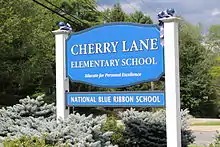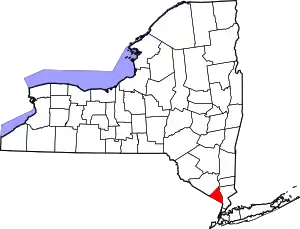Airmont, New York
Airmont is a village in the town of Ramapo, Rockland County, New York, United States, located north of the state of New Jersey, east of Suffern, south of Montebello, and west of Chestnut Ridge. The population was 8,628 at the 2010 census.
Airmont, New York | |
|---|---|
 Location in Rockland County and the state of New York. | |
 Airmont Location within the state of New York | |
| Coordinates: 41°5′57″N 74°6′0″W | |
| Country | United States |
| State | New York |
| County | Rockland |
| Incorporated | 1991 |
| Government | |
| • Mayor | Nathan R. Bubel |
| • Deputy Mayor | Brian M. Downey |
| • Trustees | Peter Blunnie, Migdalia Pesante, and Kevin Warbrick |
| Area | |
| • Total | 4.57 sq mi (11.83 km2) |
| • Land | 4.57 sq mi (11.82 km2) |
| • Water | 0.00 sq mi (0.00 km2) |
| Elevation | 584 ft (178 m) |
| Population (2010) | |
| • Total | 8,628 |
| • Estimate (2019)[2] | 8,786 |
| • Density | 1,924.64/sq mi (743.10/km2) |
| Time zone | UTC-5 (Eastern (EST)) |
| • Summer (DST) | UTC-4 (EDT) |
| ZIP code | 10952, 10901 |
| Area code(s) | 845 |
| FIPS code | 36-00408 |
| GNIS feature ID | 2391502 |
| Website | www |

The village of Airmont, incorporated in 1991, is a consolidation of the hamlets of Tallman, Airmont and South Monsey. Joseph Berger of The New York Times wrote in a 1997 article that Airmont was one of several Ramapo villages formed "to preserve the sparse Better Homes and Garden [sic] ambiance that attracted them to Rockland County."[3] In 2005, Peter Applebome of The New York Times said that Airmont was "slapped around enough by the courts to be something other than a virginal player in any discrimination case" since it ran into legal resistance to its development laws.[4]
History
In April 1991, creation of the village of Airmont was allowed in the town. Airmont had 9,500 people, including around 250 Orthodox Jews and many non-Orthodox Jews. The founders of the town said that they intended for "strong zoning" to preserve the character of the community. William P. Barr, the United States Attorney General, and Otto G. Obermaier, the United States Attorney for the Southern District of New York, filed a suit against Airmont and the village of Ramapo; Barr and Obermaier said that Airmont created a zoning plan intended to exclude Orthodox Jews from living in the village and "that other individuals acting at the behest of the defendants have engaged in a pattern of harassment against Orthodox Jews in the village."[5] The officials cited the Fair Housing Act as the relevant law.[6] The plaintiffs said that, because many Orthodox do not travel by car on Saturdays, preventing the creation of a synagogue would exclude Orthodox from the community. The Anti-Defamation League of B'nai B'rith supported the suit. The Spring Valley Chapter of the National Association for the Advancement of Colored People had opposed the creation of Airmont.[5] As a result of the suit Airmont revised its zoning code to allow religious sites.[6] Airmont's zoning restricted synagogues to 2-acre (8,100 m2) lots, which were too costly for most Orthodox congregations. A federal judge ruled that the code was discriminatory and ordered Airmont to revise the code; the legal case continued by 1997.
Around 2005, Congregation Mischknois Lavier Yakov proposed building a yeshiva and a boarding school with a 70-adult student dormitory (with provisions for their families, which could result in a population of several hundred individuals) on 19 acres (77,000 m2) of land. Town residents opposed this, causing legal action including meetings and lawsuits.[4] In 2005, the U.S. federal government filed a civil rights lawsuit accusing Airmont of discriminating on the basis of religion and violating the Religious Land Use and Institutionalized Persons Act (RLUIPA) and the Fair Housing Act by banning boarding houses.[6]
In 2011, Airmont and the federal government reached a settlement and Airmont agreed to amend its zoning code to allow Mischknois Lavier Yakov to build a school with student housing. The agreement included a $10,000 civil penalty against Airmont and marked the second time federal prosecutors had intervened in Airmont zoning affairs since its 1991 incorporation. In 2018 nothing has happened and the zoning has expired. The congregation complex will most likely never happen.[7]
On December 2, 2020, The Department of Justice filed another lawsuit, alleging that there was religious discrimination through land use policies that violate previous court rulings and federal law.[8]
Geography
Airmont is located at 41°5′57″N 74°6′0″W (41.099163, -74.100011).[9]
According to the United States Census Bureau, the village has a total area of 4.6 square miles (12.0 km2), all of it land.
The south boundary of the village is the border of New Jersey.
Demographics
| Historical population | |||
|---|---|---|---|
| Census | Pop. | %± | |
| 2000 | 7,799 | — | |
| 2010 | 8,628 | 10.6% | |
| 2019 (est.) | 8,786 | [2] | 1.8% |
| U.S. Decennial Census[10] | |||
As of the census[11] of 2000, there were 7,799 people, 2,342 households, and 2,032 families residing in the village. The population density was 1,701.3 people per square mile (657.5/km2). There were 2,362 housing units at an average density of 515.2 per square mile (199.1/km2). The racial makeup of the village was 86.30% white, 3.50% African American, 0.17% Native American, 2.53% Asian, 0.03% Pacific Islander, 1.00% from other races, and 1.36% from two or more races. Hispanic or Latino of any race were 5.26% of the population.
There were 2,342 households, out of which 41.8% had children under the age of 18 living with them, 78.0% were married couples living together, 5.9% had a female householder with no husband present, and 13.2% were non-families. 11.3% of all households were made up of individuals, and 5.8% had someone living alone who was 65 years of age or older. The average household size was 3.20 and the average family size was 3.47.
In the village, the population was spread out, with 27.9% under the age of 18, 6.0% from 18 to 24, 25.4% from 25 to 44, 26.9% from 45 to 64, and 13.8% who were 65 years of age or older. The median age was 39 years. For every 100 females, there were 95.1 males. For every 100 females age 18 and over, there were 90.0 males.
The median income for a household in the village was $87,678, and the median income for a family was $97,960. Males had a median income of $67,663 versus $36,550 for females. The per capita income for the village was $29,788. About 1.6% of families and 3.3% of the population were below the poverty line, including 2.2% of those under age 18 and 5.9% of those age 65 or over.
History
According to Cole's History of Rockland County, published in 1884, Tallman was named for Tunis Tallman, who opened a store there in 1836. Tunis was a direct descendant of Rockland's oldest family.
Government
The village is governed by a mayor and board of trustees.
Tourism
Historical markers
- Christ Evangelical Lutheran Church - Church & Airmont Road
- Dogwoods - 24 DeBaun Avenue
Landmark and places of interest
- Christ Evangelical Lutheran Church was founded in 1715, by Palatine Germans in Mahwah, New Jersey. The church was incorporated in Rockland County in 1850, and the current edifice built in 1855.
- Challenger Center for Space Science Education
- Spook Rock, near Airmont, is the largest of the cluster of rocks located on Spook Rock Road and Highview Avenue in Airmont. The Tappan and Warawankogs of the Lenni-Lenape wolf tribes, members of the Algonquin Nation worshiped the sun, moon, stars, and a spirit called Manitou.
Education

Most of Airmont is within the Suffern Central School District (formerly Ramapo Central).[12] Zoned schools include Cherry Lane Elementary School (2013 National Blue Ribbon School),[13] Suffern Middle School, and Suffern High School (New York State Reward School).[14][15][16]
Some residents, particularly in the far eastern portion of the village, are zoned to East Ramapo Central School District.[12][17]
Central United Talmudical Academy of Monsey is in Airmont.
Rockland Community College, part of the SUNY system, is near Airmont.
Notable residents
- Dennis Kay (1947 - 2012), born in Brooklyn, New York, was Airmont's mayor since 2007. He served during the Vietnam War and afterwards worked as a marketing and sales representative in the food industry prior to entering politics. He joined the Airmont Village Board of Trustees in 2002. His other roles included Boy Scout Rockland District commissioner and board member of the Hal Block Soccer League. Mayor Kay died on Sunday April 15, 2012. He was a positive force in the development of fair rights to all in Airmont and was leading Airmont out of the bad image which it has received as being anti-Semitic.
- Lipa Schmeltzer (1978 - ) is an American Hasidic singer and composer. He is a headliner within Hasidic and Haredi communities worldwide and has been called "the Jewish Elvis" and "the Lady Gaga of Hasidic music". Schmeltzer has released 13 solo albums as of 2014. In 2008, he was named to the Forward 50 of most influential Jews.
References
- "2019 U.S. Gazetteer Files". United States Census Bureau. Retrieved July 27, 2020.
- "Population and Housing Unit Estimates". United States Census Bureau. May 24, 2020. Retrieved May 27, 2020.
- Berger, Joseph. "Growing Pains for a Rural Hasidic Enclave." The New York Times. Monday January 13, 1997. Retrieved on May 2, 2009.
- Applebome, Peter. "Where Zoning Seems a Test of Tolerance." The New York Times. June 15, 2005. Retrieved on May 2, 2009.
- Sullivan, Ronald. "Rockland County Village Accused of Bias in Zoning." The New York Times. December 18, 1991.
- "UNITED STATES FILES CIVIL RIGHTS SUIT AGAINST THE VILLAGE OF AIRMONT, NEW YORK Archived 2009-03-26 at the Wayback Machine." United States Department of Justice. June 13, 2005.
- "Airmont settles federal suit, agrees to allow religious student housing". Journal News. 10 May 2011. Archived from the original on 21 February 2015. Retrieved 20 February 2015.
- "Accusations of anti-Semitism return to a New York village". The Economist. 2020-12-10. ISSN 0013-0613. Retrieved 2020-12-11.
- "US Gazetteer files: 2010, 2000, and 1990". United States Census Bureau. 2011-02-12. Retrieved 2011-04-23.
- "Census of Population and Housing". Census.gov. Retrieved June 4, 2015.
- "U.S. Census website". United States Census Bureau. Retrieved 2008-01-31.
- "SCHOOL DISTRICT REFERENCE MAP (2010 CENSUS): Rockland County, NY" (PDF). 2010 U.S. Census. U.S. Census Bureau. Retrieved 2019-11-05.
- "Cherry Lane Elementary School Profile (2018-19) - Suffern, NY". Public School Review.
- "Cherry Lane Elementary School - Airmont, New york - NY | GreatSchools". www.greatschools.org. Retrieved 2017-05-28.
- "Suffern Middle School - Suffern, New york - NY | GreatSchools". www.greatschools.org. Retrieved 2017-05-28.
- "Suffern Senior High School - Suffern, New york - NY | GreatSchools". www.greatschools.org. Retrieved 2017-05-28.
- "Educational Resources." Village of Airmont. Retrieved on May 27, 2017.
